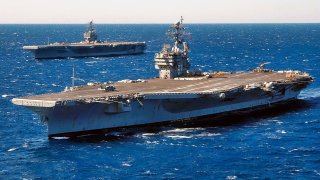The U.S. Navy's Real China Problem Won't Be Easy to Fix
In short, Secretary Del Toro has taken on an unenviable task: persuading Asian business leaders to invest in the U.S. shipbuilding complex to take on China at a time when domestic political headwinds are fierce. Profit, risk, time. Let’s wish him well.
Secretary of the Navy Carlos Del Toro recently barnstormed Northeast Asian shipyards in hopes of enlisting investment from allied nations to help revivify the U.S. shipbuilding sector. The secretary entreated the leaderships of such industrial heavyweights as South Korea’s HD Hyundai Heavy Industries and Hanwha Ocean and Japan’s Mitsubishi Heavy Industries to reopen one or more mothballed U.S. yards.
And not a moment too soon. Adding marine industrial capacity is a must if the U.S. Navy, Marine Corps, and Coast Guard are to keep pace with the challenges of our time—chiefly Chinese sea power. China, the world’s biggest shipbuilding nation, reputedly boasts over 200 times the United States’ capacity. It is flourishing in the nautical realm while America struggles. Because Chinese yards are outbuilding their U.S. counterparts at a helter-skelter rate, China will go to war with a larger navy than the U.S. Navy and it will be able to repair or replace battle losses more swiftly.
That is a big deal. The arithmetic of war is stern. A force that can speedily regenerate combat power after taking a punch, as all forces do, is resilient; one that cannot is fragile. The People’s Liberation Army Navy may not measure up to the U.S. Navy on a ship-for-ship, airframe-for-airframe, missile-for-missile basis. But the balance of resiliency yaws the PLA Navy’s way to an alarming degree. China has a bigger fleet and can replenish it faster.
Manufacturing supremacy bestows an advantage of worrisome import on Beijing.
So the strategic rationale for soliciting foreign investment is impeccable: America needs more hulls and more capacity to maintain and overhaul them. It should amass that capacity wherever it may and in a hurry. And there is precedent for what Del Toro is asking. Australian shipbuilding firm Austal already constructs warships in Alabama, for instance, as does Italy’s Fincantieri in Wisconsin. It only makes sense to add the world’s second- and third-largest shipbuilding nations to the mix.
But. What about the business rationale?
That’s less compelling, and the Navy Department needs to figure out how to burnish its case by the numbers. Look at Del Toro’s appeal through the eyes of Asian business magnates. One imagines they will evaluate any North American venture by the closely interconnected standards of profit, risk, and time. First, profit. Shipbuilders are not philanthropies. Show them the money! Company officers will crave assurances that there will be enough demand for their wares to repay their investments on these shores, plus enough more to make it worth their while. That chiefly means would-be suppliers want to know there will be sufficient demand from the U.S. government, by definition the United States’ sole customer for ships of war and merchantmen that support the fight.
Convincing Asian shipbuilders that the United States actually means to build a much larger fleet, as laid out in the navy’s 30-year shipbuilding plans, will be pivotal in negotiations. This will be a tough sell. The U.S. Navy’s inventory is still dawdling below 300 ships years after Congress mandated a 355-ship fleet. Shipbuilding budgets have fallen well short of paying for those extra 60-odd ships, remain in limbo under a continuing resolution almost halfway through the fiscal year, and are set to remain stagnant. This is a recurring pattern within the Beltway. Recalls former acting Secretary of the Navy Tom Modly: “Everyone seemed to talk a good game to each other about the requirement for the 355-ship navy, but there was no commitment, no plan, and no money to actually build one.”
Sea power is a conscious political choice, and it’s far from clear that American society as a whole has resolved to bulk up the sea services. Washington has some ‘splaining to do if it covets Asian investment.
Second, risk. Firm leaders will want assurances that the demand signal for military and mercantile shipping will remain vibrant. Otherwise they may balk at what promises to be a capital-intensive enterprise. How many resources it will take remains to be determined. Presumably naval shipyards in such ports as Long Beach and Philadelphia were laid up with an eye toward preserving and perhaps recommissioning them in some future time of crisis. But chronological age matters even if crews did their preservation job to perfection. Machinery decays. Long Beach Naval Shipyard was shuttered in 1997, Philadelphia in 1995. The degree to which buildings and hardware remain in good order after sitting idle for so long is unclear, and is sure to come up when U.S. officialdom parleys with shipbuilders. (It also appears the Philly site has undergone partial redevelopment—adding another wrinkle.)
Answering questions about the scope of the project will help HD Hyundai, Mitsubishi & Co. gauge and manage risk—making it easier to get to yes in talks. Candor pays.
If not reassured decisionmakers could blanch at the risk. Think about the politics of naval shipbuilding. To all appearances Congress has elected not to meet the martial challenges of our time. Peacetime strategy is about designing and fielding forces fit for war. That being the case, lawmakers make strategy through the budgetary process all the time. They make strategy by what they fund—and by what they don’t. As Admiral J. C. Wylie points out: “The Congressman voting on an military appropriation is, in a very real sense indeed, making a fundamental strategic decision . . . .”
And how. Refusing to approve military appropriations for this fiscal year marks a fundamental strategic decision that stasis shall prevail in naval and military affairs. Given the highly visible budgetary impasse in Washington, it’s unclear what kind of assurances U.S. naval and military leaders could concoct to show that demand for South Korean- and Japanese-built ships will remain strong and steady. Recent history says just the opposite. But the effort must be made.
And third, time. Shipbuilders will want assurances not only that an American venture will be profitable at reasonable risk, but that U.S. government orders for warships will remain robust enough to sustain yard operations for a long, long time. Constancy is a virtue on the demand side when courting the supply side. Assuming one were forthcoming, an initial burst of new-construction dollars would do little for builders if demand dwindled over the long term, leaving them operating at a loss with a wasting asset on their hands.
They might rebuff a transpacific partnership rather than risk eventual ruin.
In short, Secretary Del Toro has taken on an unenviable task: persuading Asian business leaders to invest in the U.S. shipbuilding complex at a time when domestic political headwinds are fierce. Profit, risk, time. Let’s wish him well.
About the Author: Dr. James Holmes
Dr. James Holmes is J. C. Wylie Chair of Maritime Strategy at the Naval War College and a Nonresident Fellow at the University of Georgia School of Public and International Affairs. The views voiced here are his alone.
Image: Creative Commons.


